
Other Caucasian Mountaineers
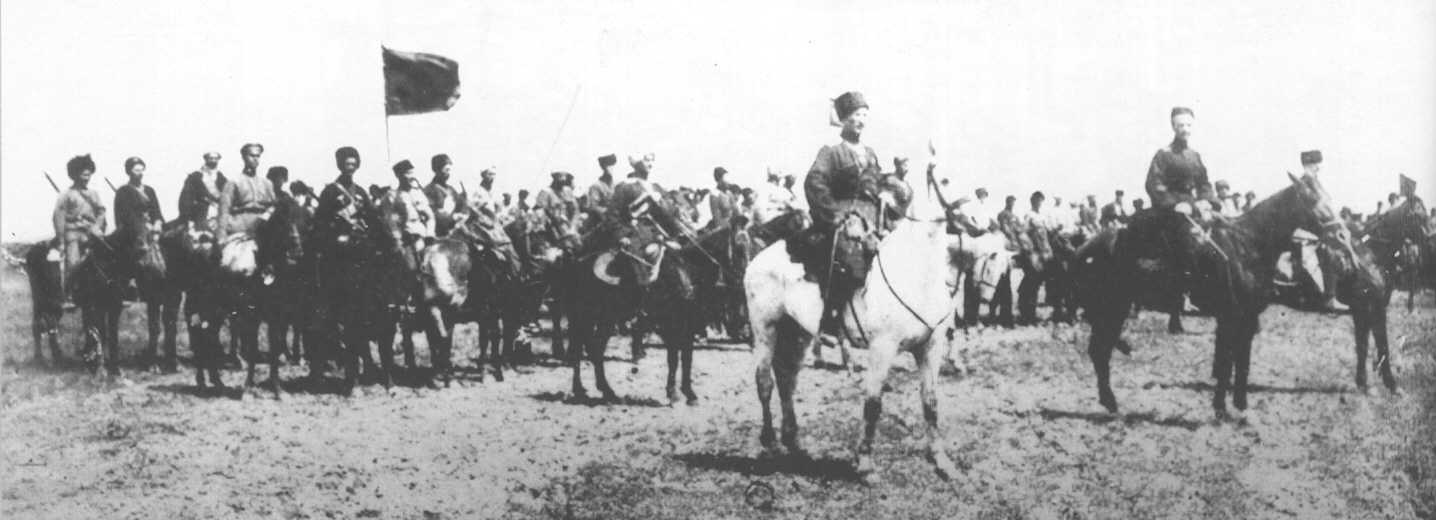
The Composite Mountain Division in 1919.
There were many units formed from Caucasian tribesmen which we cannot find sufficient detail for a separate page. They are:
Circassians, including Karachay
Kumyks
Tartars
The following groups have their own pages: Dagestanis Ossetians Kabardians and Ingush
Chechens
The Chechens are closely related to the Ingush, and Chechnya and Ingushetia were a combined ASSR in the Soviet Period.
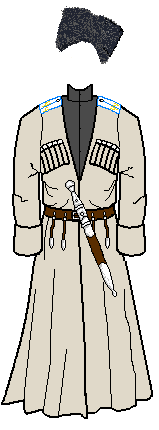 |
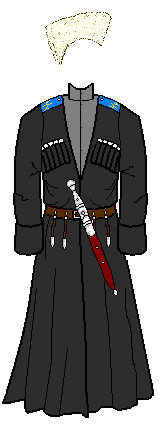 |
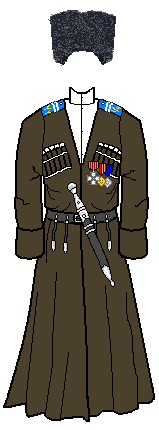 |
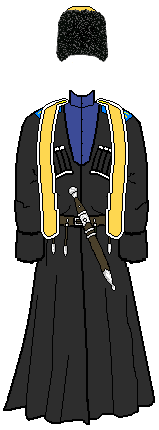 |
| Captain | Trooper | Junior NCO | Trooper with bashlyk |
Fairly speculative schemes for Chechens.
The distinguishing colour of the Chechens in the WWI-era Savage Division was light blue, with a yellow monogram that we have been unable to identify, but we would guess would have to have been Чч. Buttons and officer lace were silver. Bashlyks were yellow with white trim, so we would guess hat tops were yellow, with a white cross for officers (as strong Moslems, many may not have worn a cross).
Chechen Units in the RCW
The nature and status of the Chechens in the RCW is problematic. There may have been a Chechen Horse Division in the Astrakhan Forces Group in May 1919. By June 1919 Volkov gives a Chechen Horse Division, containing the 1st to 4th Chechen Horse Regiments and the Kumyk Horse Regiment. It was in the Forces of the Novorossiysk Area, which meant that they were either fighting Greens or on the Georgian border (in any case, not fighting the Red Army). The Chechens were then moved to the rear of the Volunteer Army, while the Kumyks went to the Caucasian Army. Klaving has them in the Forces of the North Caucasus in January 1920, with 1st - 3rd Chechen regiments and the Kumyks, but this may well only be the official position and they might still have been elsewhere.
The Division was disbanded in March 1920. Any Chechens still present in the Crimea were shuffled around a bit before being placed in the Native Horse Regiments, but these were disbanded before they saw action.
Not only did the Chechens see very little active service, and that fighting mostly partisans, it is not clear how many of them were actually ethnic Chechens. Volkov states that squadrons of the 4th Kharkov Uhlans, 14th Mitava Hussars and Crimean Tatars were part of the division. It does seem very unlikely that the ethnic Chechens, who fought bitterly for independence throughout the Civil War, would provide a whole division to the Whites, especially when their close neighbours the Ingush managed only a couple of hundred men.
Circassians
The term Circassian is a bit confusing. In English it is an arbitrary grouping of tribes from the western side of the Caucasus mountains, most of whom are Moslem. It comes from the Russian Черкес (Cherkes), from whom the term cherkeska originates. However only one portion is the Cherkes proper, a group who speak a language related to Kabardian. As a result it is not at all clear which groups the "Circassian" units were hired from.
Other Circassian groups include the Abkhaz, who mainly live in Georgia; the Balkars, from Kabardino; and the Karachay.
There was a "Circassian" Regiment in the Savage Division. Its primary colour was red, with silver buttons and lace. We assume the monogram was Чр. The bashlyk was white, and the hat tops may have been that colour too, or perhaps red.
Circassian Units in the RCW
A 600 strong Circassian Horse Regiment was formed in March 1918 under Colonel Sultan Kelech Giray. After meeting up with the Volunteer Army it was called the 1st Circassian Horse Regiment and was placed in its Cavalry Brigade. During this time the unit probably included large numbers of Russians, especially officers, who may not have been particularly "Circassian" in dress.
A 400-odd strong 2nd Circassian Regiment followed in July under Sultan Kadir-Giray, and it joined the 1st in what was now the Cavalry Division. In September the 3rd Circassian Horse Regiment, 4th Circassian (a.k.a. Kabardian) Horse Regiment, and Karachay Horse Regiments were formed as part of the 1st Native Horse Division of Colonel Shkuro.
In November the four Circassian and Karachay Horse Regiments were combined to form the Circassian Horse Division and by this stage we assume that most of the members were actually Caucasian tribesmen, or at least dressed as such. In February 1919 it was temporarily reduced to a Circassian Cavalry Regiment, but expanded once more soon afterwards back to a division, with the former 4th Regiment being merged into the 3rd.
Unlike many of the Caucasian units, these reached respectable size. In October 1919 the 1st Circassian Regiment had 662 sabres, the 2nd 523 sabres and the 3rd 691 sabres, but the Karachay Regiment was only 100 sabres. The division also contained a Reserve Regiment and the Maikop Horse-Artillery Divizion. During the retreat the units were once more combined to a regiment, then disbanded in May 1920.
At least one Circassian sotnia was part of the Composite Cavalry Regiment of the 1st Caucasian Cossack Division towards the end of 1919. It fought with the Don Army.
Kumyks
The Kumyks are a Turkic-speaking people mostly from Dagestan, but with some in Chechnya and Ossetia.
There was a Kumyk regiment in the AFSR. For a while it was brigaded with the Chechen Horse Division, but it stayed in the North Caucasus area when the Chechens went to the Ukraine.
Their uniform is unknown.
Tatars
The term Tatar (also spelled Tartar) is also confusing, but in this case not because the scope is vague, rather because there were many entirely separate Tatar groups in the old Russian Empire. In modern Russia the term means the large Tatar communities around Kazan and the Volga. However the Tsarist empire also included Crimean Tatars, Polish/Belorussian Tatars, Astrakhan Tatars, Central Asian Tatars, Siberian Tatars and Caucasian/Azerbaijani Tatars. Most of these groups formed units in the RCW, which does confuse matters somewhat.
Caucasian Tatar Units in the RCW
The Savage Division had a Tatar Regiment. In this case the Tatars were drawn from the Caucasus and Azerbaijan and dressed as other mountaineer folk.
According to the WWI Osprey the unit had red for its shoulderboards and the bashlyks were burgundy. According to Deryabin (Nationalists) the shoulderboards were red and its monogram was Тт. Oddly though, the Nikolai flag ordered for the unit was pale blue, and the field of those flags matched shoulderboard colours and the only definite photo we have suggests a pale colour. We have no information on hat top colour, but it probably matched the shoulderboards.
A Tatar Horse Divizion was formed in the Volunteer Army in December 1918, presumably of Caucasian Tatars. At least one Tatar sotnia was part of the Composite Cavalry Regiment of the 1st Caucasian Cossack Division towards the end of 1919, serving with the Don Army. It is tempting to link these two units as being related, though Volkov does not, and to suppose they wore the same uniform as the Savage Division's Tatar Regiment, whatever that was.
Tatar Units in Azerbaijan
Meanwhile the Azerbaijani Army formed its 1st Tatar Horse Regiment around men from the Savage Division. It was intended to expand this into the 1st and 2nd Moslem Horse Regiments, but this never happened.
The unit largely kept its Caucasian-style uniform, although shortages meant British and Turkish kit were also worn.
After a brief revolutionary period in which all old Imperial markings were removed, the old system was restored except the cockade was changed to a star and crescent symbol and the shoulderboards had "Azerbaijan" added in Arabic script as the monogram.
Crimean Tatar Units in the RCW
The Crimean Cavalry Regiment, which fought throughout the war for the Volunteer Army, included Crimean Tatar squadrons.
A Tatar Horse Regiment was formed from Crimean Tatars who had previously formed part of the Chechen Horse Regiments in early 1920, and this unit became part of the Crimean Corps, defending the peninsular.
In April 1920 these two units above, by now massively under strength, went into forming the 2nd Native Regiment of Wrangel's Russian Army. They were disbanded in August 1920, as were all the native cavalry at this time, though the Tatars may well have continued as a squadron of the 9th Cavalry Regiment.
There was briefly a Crimean Tatar Infantry Regiment in early 1919.
We have no information on their uniform, but the Imperial Crimean Regiment had red shoulderboards with gold / yellow monograms of Her Highness Aleksandra Feodorovna, a red-crowned furazhka with black band and silver buttons / officer lace.
Siberian, Volga and Kazan Tatar Units in the RCW
These fought the Reds in the East, from the time of Komuch through to at least 1920. They would have fought in normal Russian uniform, like their cousins the Bashkirs.
Polish Tatar Units in the RCW
The Poles formed a cavalry unit out of their Tatars in early 1919. It kept some Moslem traditions, bearing a crescent and star on its banner, and fighting in papakhi.
When this unit was badly mauled in mid-1920, the remaining men were incorporated into the 13th "Vilnius" Lancers, which was to retain a Tatar element until WWII.
Photos
We have collected various period photos of mountaineers on a separate page.